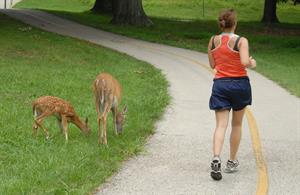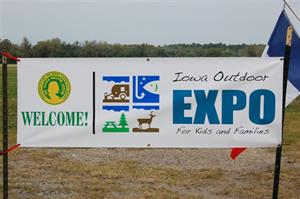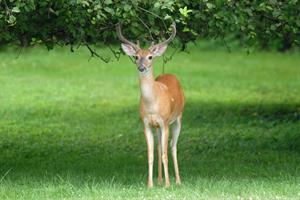Sometimes in the evenings, I listen to rock and roll. Sometimes the station is tuned to country. On one occasion, a high school band regaled me with a pulsating rendition of “We Will Rock You,” while on a different day, a spirited game of touch football provided the background sounds. And on more than half of those evenings (according to my records), I killed a deer. Welcome to deer hunting’s new frontier: bowhunting in urban and suburban America, where the whitetails are abundant – and a little more tolerant of human scent (though as I’ve frustratingly found, limits exist). This new frontier also provides opportunities for Ikes to mentor youth hunters, introduce adults to hunting, and support quality outdoor experiences for hunters with disabilities.
Taking Hunting to the ‘Burbs
For most hunters, a day spent afield is about more than bringing home dinner — it’s an opportunity to enjoy time outdoors, often with friends. Many a “successful” day hunting ends without firing a shot. While we want to teach novice hunters to appreciate those simple joys as well, there’s no denying that spotting game adds to the thrill of a first-time hunt.
Urban and suburban locations generally provide more opportunities to see a deer than a day spent in the woods or on a farm. Landscaped yards offer a buffet of tempting treats (pansies seems to be a fall favorite), and there are few predators other than humans. It’s the sheer abundance of deer that, in my opinion, makes urban archery a superb way to introduce people to hunting. For busy youth (and adults) just learning to hunt, it can also be easier to schedule a few hours in a suburban tree stand than to find a day to spend at the closest wildlife refuge. Think of it as a “gateway” hunt.
If you’re looking for a downside to going afield in the ‘burbs, most localities allow bowhunting only, and it can take several years for children and adults to master shooting a compound or recurve bow with great accuracy. Young folks can speed up their archery learning curve by participating in an “Archery in the Schools” program. Many novices have turned to crossbows — the learning curve is shorter and they are generally more accurate than a compound bow.
Laws on urban hunting vary from state to state and even among counties in the same state. In Virginia, for example, the two counties in which I bow hunt for deer are adjacent yet have different regulations. Roanoke County is one of the few in Virginia that allow urban archery county-wide. (Across most of the state, urban archery regulations are specific to a city or town.) Roanoke County laws specify that urban archers must shoot from a stand at least 10 feet off the ground and that no one except the landowner can discharge arrows within 100 yards of a dwelling.
Next door in Botetourt County, urban archery is not permitted at all. However, a landowner who suffered extensive deer damage to his cornfield (which borders an apartment complex and single-family homes), garden, and yard arranged for the Virginia Department of Game and Inland Fisheries to issue me a permit to take antlerless deer from his fields before the corn harvest. The landowner asked me to hunt from a tree stand 40 yards from his back door.
This was actually the first place I gained permission to bow hunt in the ‘burbs. In fact, the landowner contacted me directly and begged me to come. Then a friend of his did the same after I had killed a few deer on the first property. I’ve also gained permission by calling folks and knocking on doors — the same as I would for hunting on a rural property.
Expanding Access to Hunting

Robin Clark has been hunting in Virginia for more than four decades, including three decades from a wheelchair. He understands how difficult it can be to find wheelchair-accessible areas to hunt. Clark says that going afield in urban and suburban neighborhoods helps solve one of the biggest problems hunters like him often face.
“Access is a major problem facing hunters with disabilities,” Clark explains. “It’s a lot easier to roll though someone’s backyard than [it is] to go into the forest and hope that there is a handicapped-accessible road that has been maintained and a reasonable chance that game will be present.”
“Many times, suburban and urban hunting also allows people like me to go hunting by themselves,” he continues. “It’s much easier for me to call a friend to come to someone’s backyard to [help me] field dress a deer than it is for them to track me down out in the national forest.”
Clark agrees that hunting in the ‘burbs is also helpful for disabled sportsmen because deer are not as wary about human scent. “I spend 16 or more hours daily in my wheelchair,” he says. “There’s no way it will ever be scent-free, no matter how much scent eliminator spray I apply.”
Clark volunteers as the state coordinator for the Virginia Wheelin’ Sportsmen, a group dedicated to “providing exciting outdoor opportunities to all people with disabilities,” including hunting, fishing, and shooting sports. The National Wild Turkey Federation (NWTF) launched the Wheelin’ Sportsmen program in 2000. Today, NWTF chapters host Wheelin’ Sportsmen events across North America to “help participants gain a sense of independence by learning to stay active in the outdoors on their own between events.”
With upwards of 400 members, Virginia is the largest Wheelin’ Sportsmen state group and holds around 35 events each year. Hunting is not limited to turkeys. “For our fall deer hunts, we often have 100 to 120 individuals who want to participate,” Clark says. Given the popularity of these events, he thinks there’s plenty of room to expand — including by partnering with Izaak Walton League chapters.
League Chapters Connect with Urban Opportunities
Many League chapters around the country are engaging youth, adults, and people with physical challenges in the outdoors through shooting sports. Some chapters have tied this outreach to urban/suburban bowhunting.

The
Des Moines Chapter in Iowa, for example, uses its annual community expo to “match up the needs of handicapped hunters, new adult hunters, and perspective youth hunters to get them out in the outdoors,” says Rick Cerwick, former chapter president who currently chairs the Iowa Outdoor Expo. “We show them what to do in terms of hunter education, finding places to hunt, and what agencies to contact and resources to tap into.” The expo regularly reaches more than 10,000 local residents.
“We’ve found that people at the Expo are very open to becoming hunters, especially kids and young dads,” Cerwick says. “It helps that there are urban bowhunting zones in this area. We also show folks how to tap into their network of people they know to find places to hunt.”
Polk County (where the Des Moines Chapter is located) launched an urban bowhunting program in 1996 based on recommendations from the Polk County Deer Task Force. Hunting is allowed in designated deer management zones on public and private land. Potential hunters must pass a bowhunter safety education course and an archery proficiency test. More than 320 antlerless deer were harvested during the county’s 2015-2016 bowhunt season, including 132 deer in Des Moines.
Highly urbanized Fairfax County, Virginia — a suburb of Washington, DC — is home to one of the largest urban/suburban deer herds in the country. The League’s
Arlington-Fairfax Chapter is trying to help keep that herd under control. “Hunter education classes held at our chapter each year introduce new people to hunting and firearms safety,” says Dick Reimer, the chapter’s field archery director. “We offer introduction to archery classes throughout the year and maintain tree stands for hunters to use for practice. We also have more than 150 archers each year come to our chapter to qualify to participate in the Fairfax County Archery Program.” The Fairfax County Park Authority uses bowhunting as a deer management tool. According to the county’s website, “Archery is the primary deer management tool used in Fairfax County to help manage high-density deer herds.” In addition to the proficiency test, applicants must have taken a hunter safety course and undergo a criminal background check. Approved hunters are assigned a specific park — which range from 4 acres to 1,149 acres — for the bowhunting season.
Urban Hunting Benefits Local Ecosystems

The pursuit of urban and suburban whitetails is about more than convenience — it’s essential to balancing ecosystems. “Without predators removing a percentage of the herd every year, deer populations quickly grow, and they eat more than an ecosystem can sustain,” says Reimer. “In an urban environment such as parks, a variety of plants may be lost to overbrowsing. The area becomes less supportive of smaller animals and birds.”
It’s also about safety. In areas with higher deer densities, ticks are often more common — as are the diseases they spread, including Lyme disease, says Reimer. Before urban deer seasons, vehicle collisions often “managed” local herds — with life-threatening results for drivers. Or communities hired sharpshooters, which can be a costly endeavor. “Deer sterilization” programs have been proven ineffective on free-ranging herds.
“That brings us back to urban archery being the most efficient and safe method of controlling the urban deer population, with no expense to taxpayers,” says Reimer. “The improvement to the ecosystem system, fewer traffic accidents and human injuries and deaths, plus fewer people and pets coming down with Lyme disease are just a few of the reasons to support urban archery seasons.”
Archery hunting is also proven to be safe, he says. “In Fairfax County, a large percentage of the parks are archery hunted at the same time the parks are open to the public each year,” and there have been no unintended injuries due to mixed use of the land. In addition, “many of the urban deer harvested are donated to programs like Hunters for the Hungry, feeding less fortunate people in Virginia. The more people who understand this, the more people will open their properties up for archery hunting to help control a growing urban deer population.”
Reimer says that over the past 15 years, he has been able to harvest 20 to 39 whitetails annually in Fairfax County. (There is often no bag limit for urban deer hunting.) “I have had property owners tell me how happy they are that the deer numbers are being reduced and their plants may have a chance [to survive],” he says. “Property owners often ask me what venison tastes like because they have never eaten any. So I offer to drop a package by and even offer tips on preparing it” — a great tip on building relationships with neighbors if you are looking for permission to hunt someone’s property.
“Looking back 20 years, most urban property owners were against archery deer hunting, and it was very hard to find people who would let me hunt on their property,” Reimer recalls. “My most satisfying experience would be all the people’s attitudes I have been able to change over the years.”
I’ve seen similar positive shifts in attitudes about hunting among my neighbors in central Virginia.
Opportunities for Mentoring — and a Full Freezer
Two years ago, a fellow teacher asked me to help her out with a “terrible problem.” At first I assumed this had something to do with a wayward student or school bureaucracy, but my hunting skills were what she wanted.
“The deer are everywhere in our neighborhood, and they are eating just about everything that grows in our yard,” she said. “Can you come over with your bow and do something about it?”
After contacting the local game warden and being assured that I could legally bowhunt in the teacher’s backyard, my wife Elaine and I began scouting the area. During evening drives on the one mile or so road that meanders through the neighborhood, we always counted dozens of whitetails — the best evening was when we tallied 59.
I set up a ground blind in the teacher’s backyard and arranged to come by on opening day of Virginia’s archery season. When I arrived that afternoon at 2:15pm, her husband was mowing the yard. “Go sit in the blind,” he yelled over the roar of the mower. “I’ll be done around 2:30. The deer will smell the cut grass and be here directly.”
My hunting records show that at 2:45pm, I killed a nice doe and decided to come back the next morning. Three minutes after legal shooting light, eight deer entered the backyard, and I killed one of my largest does ever — a five-year-old whitetail that weighed more than many of the bucks I have taken.
To avoid potential surprises, my teacher friend had contacted her neighbors to let them know I would be afield and when. This, in turn, led to one neighbor asking me to bowhunt in her backyard as well. As word spread, yet another teacher at school asked me to come to her neighborhood, and I arrowed a fine, mature doe on my initial visit. Over the past two seasons, I’ve killed 13 deer in these various backyards.
I also realized this was an opportunity to mentor others. I told another fellow school teacher (and new hunter) Doak Harbison about my successes and he eagerly asked to participate. Three of the four deer Doak has harvested to date came from suburban settings. One of my students at school, Will Burkette, asked to come “to the neighborhood” as well, and the young man arrowed a large, mature doe on his initial outing.
Before beginning my urban/suburban archery “career,” I was concerned that residents would not like me bowhunting in their neighborhoods. But I have not met anyone who has been aghast at my presence. One gentleman who lives across the street from a backyard where I hunt eagerly gave me permission to come into his yard any time to retrieve a deer. A week later, I had to do just that. And when I was field dressing that doe, two other neighbors out for a walk asked if I needed help in lifting the overgrown whitetail into my truck. Their assistance was much appreciated.
Bowhunting in America’s suburbs is a marvelous way to introduce youth, adults, and physically challenged individuals to the outdoors. It’s also a great way to recruit new League members and spread our conservation message, educating the public about the vital role that hunters play in ensuring continued high-quality wildlife habitat.